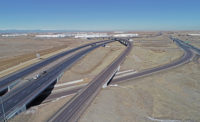Interstate 10 and Loop 303 Interchange Phase II
Goodyear, Ariz.
Best Project
Owner/Developer: Arizona Dept. of Transportation
General Contractor: Pulice Construction Inc.
Lead Design Firm, Structural, Civil: AZTEC Engineering Group Inc.
Transportation and Geotechnical Engineer: HDR Inc.
Civil Support: NFRA Inc.
Materials Testing: ACS Services
Drainage: J2 Engineering and Environmental Design LLC
SubContractors: Adra Contracting; Bob’s Barricades; Paveco
The interchange for Interstate 10 and Loop 303—Arizona’s largest traffic interchange—is being used as a model for future projects, based on its innovative traffic control plan that allowed I-10 to stay open during construction.
The five-level interchange includes 14 bridges as well as multispan freeway ramps 75 ft above existing grade. Utility relocation was an additional challenge. Crews converted a historic irrigation canal into a multicell box culvert and relocated two miles of double circuit overhead power lines.
Eric Prosnier, project manager, Arizona Dept. of Transportation, says more than 2 million cu yd of dirt was removed from the interchange project site and used as barrow on five adjacent parcels. Haul routes and other excavation functions were written into project specifications, eliminating related delays, he adds.
As the area is naturally impacted by rainwater thanks to close proximity to the White Tanks Mountains and nearby rivers, flood control was a vital concern. Additionally, the Roosevelt Irrigation District system is adjacent and within the project corridor. To address these issues, the project team implemented a drainage concept involving several large basins and channels, along with a 72-in. gravity drain.
Tony Bokich, associate vice president with AZTEC Engineering, says early design plans required construction for a new pump station, but the water design team determined the 72-in. gravity drain would sufficiently handle stormwater. Gravity drain construction costs compared with the pump station were competitive at the capital level, but advantageous over the costs of long-term maintenance.
Phase 1 of the two phase project included constructing two flyover bridges and the frontage road system. The frames of the two additional flyovers were later constructed over the realigned I-10.
Phase 2 included completion of the Loop 303 directional ramps to the south of I-10 and construction of Loop 303 from its current termination just north of McDowell Road to Van Buren Street. Major scope during this phase included excavation, aggregate base, PCCP, asphaltic concrete pavement and building eight cast-in-place, post-tensioned and box-girder concrete bridges.
The construction team on this project had worked together on Phoenix metropolitan freeways for nearly a decade, including 90% of the subcontractors. The synergy of this long affiliated team allowed Phase 1 delays such as a power pole placed along a detour route to be made up during Phase 2.
Local leaders also credit the interchange with business growth, including $738 million of capital investment, increased sales tax revenue and a 758% increase in property taxes in the areas immediately adjacent to the project.
“This interchange continues to play a key role in economic development plans for Goodyear and other West Valley communities,” says Goodyear Mayor Georgia Lord.
Part of the appeal of the area that is bolstered by this traffic interchange comes from the artwork coordinated by AZTEC. On the Van Buren Street overpass, for example, is a depiction of an agricultural scene, reminiscent of the area’s past.





